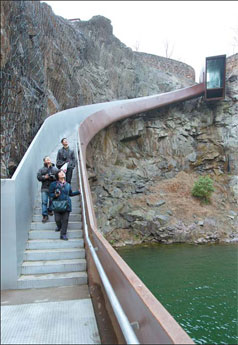Digging deep to discover beauty
Updated: 2013-04-11 07:20
By Zhang Yue (China Daily)
|
||||||||

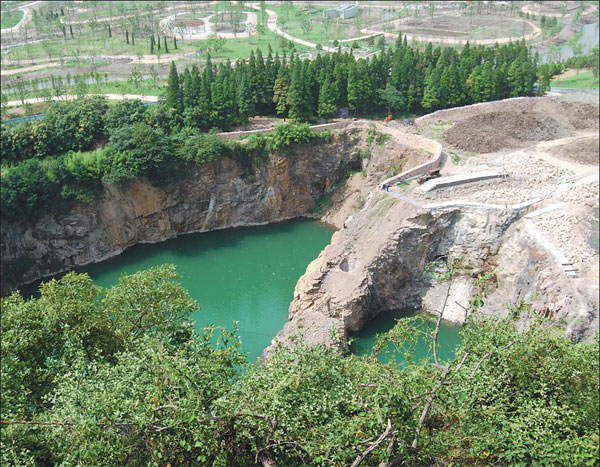
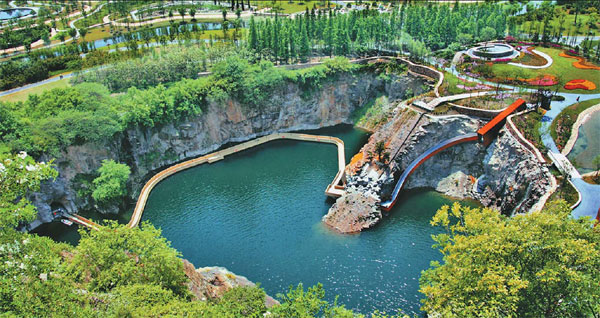
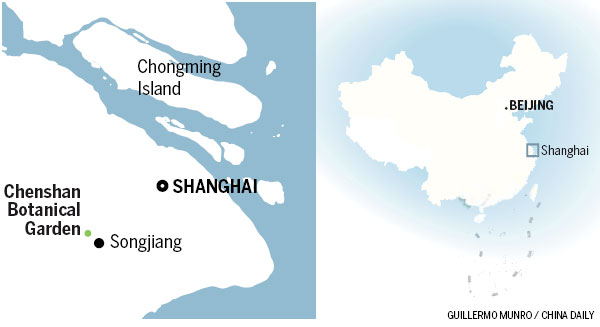
An abandoned quarry in Shanghai has been transformed into an award-winning park that celebrates its industrial past. Zhang Yue reveals the people and history behind the huge project.
Zhang Derong, 58, stands on the spot where his old home once stood, where he lived most of his life, and looks out over a quarry garden in Shanghai. "I don't recognize it at all," he says. The only remnant of the past is a 60-meter deep quarry that is now a landscaped feature of Chenshan Botanical Garden in Songjiang district. "It's such a tranquil and beautiful place now," he says, "and it's fantastic that the years of noise and danger caused by mining have simply faded away."
The quarry garden is an approximately two-hour drive from downtown Shanghai and opened up to the public just before the 2010 Shanghai World Expo.
|
An iron and steel bridge leads visitors from the quarry's top down to the lakeside 30 meters below. Gao Erqiang / China Daily |
Over the past three years it has come to international attention, winning a British Association of Landscape Industries award in 2011. The following year the American Society of Landscape Architects honored the park for being innovative and "restoring the ecology of the quarry, creating a natural and cultural experience in an Oriental style".
"It was my most challenging project ever," says professor Zhu Yufan from the School of Architecture, Tsinghua University, who led the design and reconstruction efforts, costing 32.84 million yuan ($5.3 million) over three years. "But I am so glad that we did it. It was totally worth the effort."
The quarry site on the south side of Chenshan Hill had been mined for decades and its igneous rock was used to build the foundations of Shanghai, its roads and buildings. The quarry was closed in the 1980s and the site lay barren, while the quarry itself filled with water.
Zhang Derong, who was born and raised in Chenshan village, just 100 meters from the quarry, recalls riding cows home after school, and rocks falling on his old house because of the quarrying.
"Soldiers and the mining company always helped repair the house, but the mining never stopped despite the dangers," he says. "It was an important source of income for the village."
Zhu, the designer, says incorporating the history of the mine was central to his plans for reconstruction.
"The site was formed as a result of industrialization. This is something that had a big impact on me when I first saw the quarry lake, and I wanted visitors to remember this," he says.
Zhu used iron and steel as the principal materials to create the project. "I wanted the place to have an industrial smell rather than mask it with something fragrant."
It was the first time Zhu, who specializes in urban garden design, landscaped a quarry.
"I didn't like the idea of creating a quarry hotel on the site because that would mean a higher density of visitors," Zhu says.
"Reconstructing a quarry was a new and interesting idea to me. It was originally suggested that we should fill in the quarry, which I thought was hilarious. I later learned that this is a common way of dealing with abandoned quarries, but it is too crude and not necessarily safe.
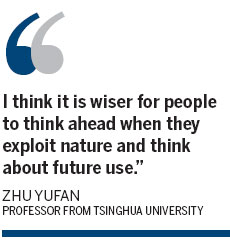
"I think it is wiser for people to think ahead when they exploit nature and think about future use."
He insisted on keeping the quarry lake, making it the centerpiece of the botanical garden.
In addition to creating a waterfall, with water pumped from the lake, Zhu and his design team conceived the idea of constructing a bridge that would allow visitors to walk from the top of the quarry down to the lakeside 30 meters below.
Safety issues were paramount, Zhu says. In the original plan the idea was to build a bridge alongside the hill, but since the rocks would require time to weather and stabilize, a floating bridge across the quarry lake was constructed instead, which also allows visitors to stroll across the water.
For the construction of the double-curved bridge that transports visitors from the viewing deck to the lake, the design team worked closely with Beijing's Zhong'ao Environmental Sculpture, which specializes in iron and steel.
It took five months to build the double-curved bridge, which has one side made of rusted iron and the other of burnished steel, says Zhu Yunlei, project manager of the sculpture company.
"It was really difficult for us to put the two sides of the bridge together at the quarry site," Zhu says.
Firstly, the two sides of the bridge were produced in sections, in Beijing, and then transported to the site. "Assembly was difficult and dangerous because the heavy machinery and materials caused rocks to fall."
Since Chenshan Botanical Garden opened in April 2010, it has proven to be a popular destination for sightseers, particularly photographers. In 2012 there were 700,000 visitors.
As for the 500 households of Chenshan village, they were relocated in 2006 to the residential area of Jiangqiu Xinyuan, about 1.5 km from the quarry.
For villagers like Zhang the park is now an inspiring memento of the area's industrial past.
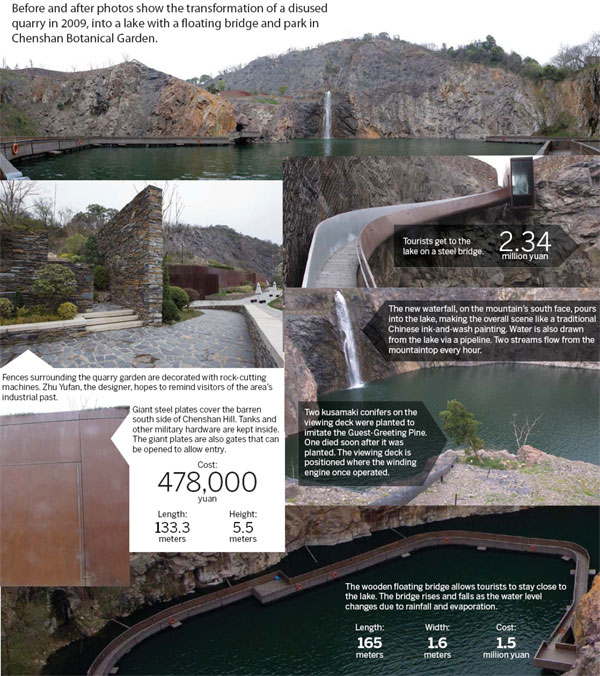

 In Photos: 7.0-magnitude quake hits Sichuan
In Photos: 7.0-magnitude quake hits Sichuan
 Li Na on Time cover, makes influential 100 list
Li Na on Time cover, makes influential 100 list
 FBI releases photos of 2 Boston bombings suspects
FBI releases photos of 2 Boston bombings suspects
 World's wackiest hairstyles
World's wackiest hairstyles
 Sandstorms strike Northwest China
Sandstorms strike Northwest China
 Never-seen photos of Madonna on display
Never-seen photos of Madonna on display
 H7N9 outbreak linked to waterfowl migration
H7N9 outbreak linked to waterfowl migration
 Dozens feared dead in Texas plant blast
Dozens feared dead in Texas plant blast
Most Viewed
Editor's Picks

|

|

|

|

|

|
Today's Top News
Live report: 7.0-magnitude quake hits Sichuan, heavy casualties feared
Boston suspect cornered on boat
Cross-talk artist helps to spread the word
'Green' awareness levels drop in Beijing
Palace Museum spruces up
First couple on Time's list of most influential
H7N9 flu transmission studied
Trading channels 'need to broaden'
US Weekly

|

|
